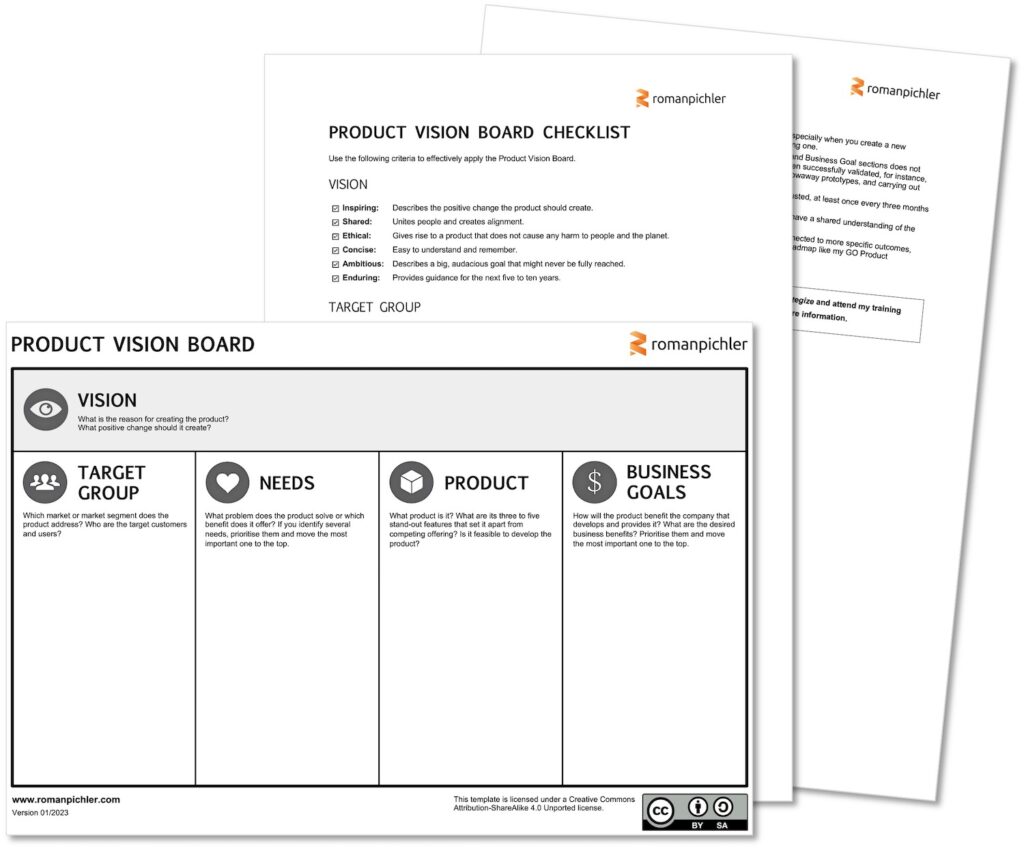I designed the product vision board to be a simple yet effective tool to capture the product vision and the product strategy. Despite its simplicity, it's not always easy to effectively apply it. This article introduces a checklist to help you get the most out of the tool.
Overview
The product vision board offers five sections. The vision captures the ultimate purpose for offering a product. The target group characterises the product’s users and customers. The needs describe the problem the product should address or the benefit it should offer. The product section states its standout features. The business goals capture the desired benefits the product should achieve for the company developing and providing it.
The checklist below states criteria to get the five elements of the product vision board right. Additionally, it offers criteria that apply to the entire board or its bottom sections. You can download the checklist together with the product vision board template by clicking on the image below.
If you are new to the product vision board, then I recommend that you read the article The Product Vision Board or watch my YouTube video called Product Vision Board Introduction before you use the checklist.
Vision
Inspiring: Describes the positive change the product should create.
Shared: Unites people and creates alignment.
Ethical: Gives rise to a product that does not cause any harm to people and the planet.
Concise: Easy to understand and remember.
Ambitious: Describes a big, audacious goal that might never be fully reached.
Enduring: Provides guidance for the next five to ten years and is free from assumptions about the solution.
Target Group
Clear: The target group is clearly characterised, for example, by using demographics and behavioural attributes.
Specific: You can tell if somebody is included in the target group or not.
Cohesive: The members of a target group share similar attributes, e.g., age, lifestyle, disposable income. If that’s not the case, then break up the target group and form several subgroups.
Needs
Outcome-based: Capture the reason why people would want to use the product. Describe what success looks like from the perspectives of the users and customers.
Specific: The needs are detailed enough so that you can validate them.
Focused: Concentrate on the main problem/benefit, the main reason for people to use the product.
Prioritised: If you do identify several needs, prioritise them according to their importance for the target group.
Product
Type: It’s clear what kind of product you want to offer, for example, mobile app on Android and iOS.
Differentiated: The aspects of your product that make it stand out, set it apart from alternative offerings are stated.
Focused: There are no more than five standout features.
Big: The features are coarse-grained product capabilities; no epics and user stories!
Business Goals
Outcome-based: The desired business benefits, the company’s reason for investing in the product, are clearly described, for example, generating revenue, increasing brand equity, reducing cost.
Specific: The business goals are detailed; state rough targets if possible.
Prioritised: If more than one business goal is identified, order them according to their business impact.
Overall Criteria
Needs-first: Start with the needs after you’ve captured the vision especially when you create a new strategy—be it for a brand-new product or for an existing one. An example for the latter would be a life cycle extension, for instance, by addressing a new market.
Validated: The statements in the Target Group, Needs, Product, and Business Goal sections does not contain any major hypotheses and risks. They have been successfully validated, for instance, by interviewing and observing target users, building throwaway prototypes, and carrying out competitive analysis.
Adaptive: The product vision board is regularly inspected and adapted, at least once every three months as a rule of thumb.
Shared: The key stakeholders and development team members have a shared understanding of the product vision board contents.
Connected: The strategy captured on the board is systematically connected to more specific outcomes, preferably to an outcome-based, goal-oriented product roadmap like my GO Product Roadmap.


Post a Comment or Ask a Question
4 Comments
I wonder, if the 3-5 coarse grained features aren’t a bit redundant when going into the product roadmap. Don’t they also catch 3-5 features for every product goal? I guess, that what I am asking is: how to best differentiate the features in the vision template from those in the roadmap template.
Thanks for your comment, Hector. The features on the Product Vision Board capture those aspects that make a product stand out from the competition and give it a competitive advantage–which is especially important for revenue-generating products. Take “speed, simplicity, and safety” of the original Google Chrome browser as an example. The features on the GO Product Roadmap sketch the likely outputs and deliverables, which have to be created to meet the corresponding product goal. While they should be coarse-grained, they are more detailed than the standout features of the Vision Board.
There is no direct connection between the features on the Product Vision Board and the GO Product Roadmap. But as the goals on the roadmap have to be aligned with the needs and business goals of the Vision Board, and as the standout features of the board have to help meet the needs, the features on the roadmap are indirectly connected to them (there is a transitive relation between them). Hope this helps!
Thank you so much, Roman! This is very helpful. (I didn’t receive a notification on your comment, and thus I missed it to answer).
You’re welcome, Hector. I’m glad that my reply was helpful.